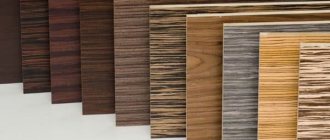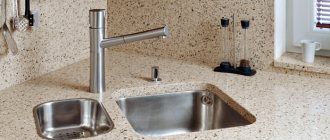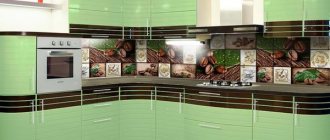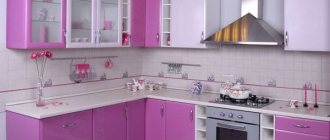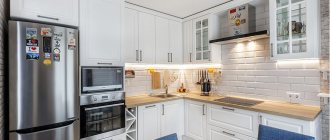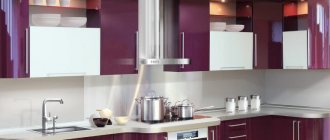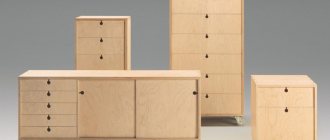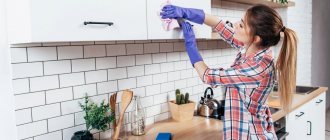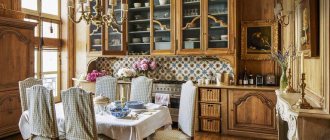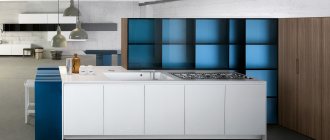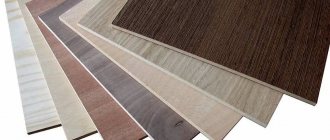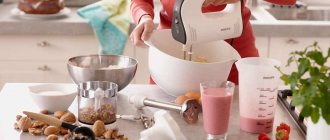Stylish furniture made from natural MDF furniture board is known for its reliability and high strength. Thanks to the properties of the board, furniture facades can be decorated with milling. A huge number of colors and textures provide fashionable aesthetics to furniture sets. The material has universal characteristics, moderate cost and minimal maintenance, which is why it is popular among buyers.
To protect the surface and obtain different decor options, plastic and special films are used.
MDF facades: PVC or paint?
Kitchen with MDF film facades MDF facades are very popular.
Kitchen furniture with such fronts is preferable to solid wood furniture. Firstly, because solid wood is more expensive. Secondly, such material is less practical. Despite the fact that MDF is essentially sawdust. MDF facades have the following advantages:
- strength
- durability
- resistance to external negative influences
Environmental friendliness is another advantage. No harmful substances are used when pressing sawdust. They stick tightly to each other due to the release of a special substance contained in the wood. The problem of choice does not end there.
Which ones should you choose?
Each of the facade options proposed above has its own disadvantages and advantages. In general, thanks to modern production technologies, they all work perfectly in the kitchen, but there are nuances. For example, painted facades, unlike film ones, cannot have a wood structure or pattern, but we have the opportunity to give them absolutely any color. The disadvantage of plastic facades is that milling cannot be done on such facades. At the same time, there is a definite plus: they can withstand temperatures up to 240 degrees Celsius (according to some experiments, even more).
Solid wood facades are a very individual product that is not suitable for everyone. Firstly, they are quite expensive compared to all other options. Secondly, they require proper conscious care. But with good care they will last in the kitchen for up to 50 years, and possibly longer.
Panel finishing elements
Materials made from polyvinyl chloride and medium-density wood fiber boards for cladding wall and ceiling surfaces are produced in the form of panels of various widths, with a variety of decorative loads and surface textures. In terms of decorative properties, giving preference to one or another option seems to be quite a difficult task. This is explained simply: PVC and MDF panels have almost complete artistic identity.
The method of installation of elements made of polymer and wood fiber is also not significantly different. They are mounted on a preliminary prepared frame. This technique carries with it a certain number of disadvantages in the form of loss of room space, and some advantages: sound or heat insulating material can be laid in the frame space.
Another common advantage of PVC and MDF panels is the finish of their front surface. Walls and ceilings constructed using this material do not require additional finishing processes and are equally amenable to cleaning measures.
The environmental indicators of polyvinyl chloride and compressed wood fiber are also in balance with each other and comply with all sanitary and hygienic standards for toxic and hazardous substances released. PVC and MDF materials are even approved for use in children's and medical institutions.
Production of MDF with paint and MDF with film
The film is applied to MDF facades using a press, creating high temperature and vacuum. Paint is applied under normal conditions: at “room” temperature, with existing atmospheric pressure. First, the surface of the MDF facade is coated with a primer. Next, a special enamel is applied. If necessary, additional layers of enamel are applied and the façade is varnished.
The properties of furniture facades also depend on coating technologies.
PVC (polyvinyl chloride boards)
PVC (polyvinyl chloride) is one of the types of plastics that is widely used as a finishing and structural material. More precisely, for these purposes it is not PVC itself that is used, but multilayer boards based on it.
One of the most common forms of PVC production is volumetric panels with an internal cellular structure, the so-called PVC lining. They are used in decoration, both internal and external. Such a wide range of uses is due to three important advantages of the material:
- Moisture resistance. The material is not damaged either by contact with air of high humidity, as in bathrooms, or by direct wetness. Both the structure and appearance of the panels are preserved;
- Easy to install and light weight. Placing PVC panels does not require the use of any special equipment, or even imparting load-bearing properties to the base due to the low weight of the finishing material;
- Varied design. The production technology of PVC panels allows you to give them absolutely any appearance - from imitation of wood texture or tiles to full-fledged photo printing.
At the same time, volumetric PVC panels (“lining”) have extremely low mechanical stability. They are easily damaged by any impact, covered with scratches and cuts. They also do not have load-bearing properties. But they can bend while maintaining performance characteristics.
However, PVC has a very important drawback - this material is not at all resistant to heat. Already at +60 degrees it begins to deform. But the main thing is that when heated, PVC releases harmful and toxic substances that enter the air and have poisonous properties.
As a result, PVC cannot be used when decorating children's rooms and kitchens, placed in direct sunlight or next to heaters or radiators. It is recommended to use this material with caution for lining pipes with hot water - although, of course, its temperature is usually 60-75 degrees.
PVC is not resistant to low temperatures. In frosts of -15 degrees and below, it becomes very fragile and breaks easily even with the weakest mechanical shocks. If internal tension was created in the PVC panels when covering the facade - for example, when fixing with self-tapping screws - then they may crack when it gets colder.
On the other hand, when used in the normal temperature range from -10 to +60 degrees, PVC panels are safe and convenient.
In general, PVC is characterized as follows:
- The base is a plastic plate (vinyl chloride polymer, 57% chlorine, 43% ethylene);
- The strength characteristics in any case leave much to be desired, but due to high wear resistance and ductility in the absence of mechanical shocks and similar damage, the panels can last forever;
- They have low environmental friendliness. Safe only when used in a certain temperature range (up to +60 degrees) and without contact with direct sunlight or heat;
- Well suited for use in bathrooms as they are resistant to moisture; It is better not to place them in kitchens and children's rooms due to the emission of harmful substances when heated.
The PVC used in finishing also has an attractive appearance. Its texture can imitate the natural shine of materials including varnished wood, ceramic slabs or natural stone. However, PVC panels for finishing facades are usually simply painted with light-absorbing paints in a uniform tone and cannot boast of such visual appeal.
Disadvantages associated with low environmental friendliness only appear if the PVC is heated. At room temperature this plastic is safe. In addition, it is odorless and does not irritate the skin.
Advantages
- Low price.
PVC panels are one of the cheapest finishing materials. The cost per square meter of “lining” ranges from several hundred rubles. In addition, their placement will also not lead to additional costs, since they do not require foundation preparation and are lightweight; Resistant to water and moisture. - Design variety. PVC panels can imitate the texture of wood, tiles, stone, be painted evenly, support photo printing, and so on;
- Easy to use. They do not require any super-reliable fastenings, have a certain elasticity and resilience, and can be placed by gluing, screwing or in siding-type guides;
Flaws
- Low mechanical strength. Easily damaged by impact and piercing-cutting influences;
- Low thermal strength. The recommended operating temperature range is from -10 to +60 degrees;
- Low environmental friendliness. When heated, PVC begins to release harmful substances.
It is worth mentioning that PVC is used in decoration, design and production of furniture extremely rarely. Typically, various additional substances are added to its composition, including plasticizers, softeners, heat stabilizers, softeners and even lead. All of them further increase the danger of the material - but only when heated, when the PVC structure is sharply destroyed.
Comparative analysis
Furniture facades MDF PVC and facades coated with paint have certain features that it is advisable to analyze and compare in order to make the right choice. Let's make a comparison:
- Film is cheaper than paint. Consequently, film-coated facades will cost less.
- The film is more resistant to mechanical stress. It is not as easy to scratch as it seems. It can withstand relatively high temperatures. Not afraid of moderate exposure to ultraviolet radiation. A surface coated with paint is easier to damage as a result of mechanical stress.
- You can clean the film surface without paying special attention to the choice of cleaning product. A painted façade can only be cleaned of dirt using special products.
- MDF PVC kitchen facades are somewhat less moisture resistant. Read the rules for using facades!
- When covering a facade with enamel, you can combine colors and create different effects. When using film, this is more difficult to do.
Here are just a few comparisons that already show that paint and film are completely different coatings with different properties.
Film is more practical and costs less. Therefore, you need to proceed from what is more important for a person who wants to purchase a kitchen with MDF facades. To dispel doubts about the quality of film facades, we wrote an article MDF facades: myths and misconceptions!
MDF White wood + gold patina
Kitchen facade patina silver
MDF facade with “Wave” milling
Kitchens: laminated chipboard, PVC film, plastic, MDF gloss, enamel - the pros and cons of materials
When choosing facades for your kitchen, it is advisable to focus on three significant criteria: financial capabilities, aesthetic preferences and performance properties of materials.
When choosing facades for your kitchen, it is advisable to focus on three significant criteria: financial capabilities, aesthetic preferences and performance properties of materials.
KITCHENS FROM LDSP Chipboard is a laminated chipboard, i.e. This is chipboard, which is covered with a special film using lamination - a special physical and chemical procedure. Because of this cladding, the appearance of the chipboard improves and its reliability increases (as far as possible). Laminated chipboard is a “loose” material, so it deforms quite quickly. Laminated chipboard is used for the facades of kitchen units if it is necessary to make the most budget-friendly kitchen option. Laminated chipboard does not meet the basic requirements for kitchen facades.
A kitchen with laminated chipboard facades can be recommended either for a rented apartment, or for a country house, or as a temporary option.
Advantages of laminated chipboard facades: low price; the ability to produce facades of non-standard sizes without a large increase in price.
Disadvantages of laminated chipboard facades: they look simple; low moisture resistance; over time, the fastenings of the facades and the body become loose; facades are deformed; difficulty in care; the edge often peels off from the ends; short service life.
KITCHENS MADE FROM PVC FILM – are made by gluing the film to the slab material with special glue using a press.
The price of kitchens coated with PVC film indicates that only laminated chipboard is cheaper than film. However, in the furniture market of the Far Eastern Territory, the price of film facades is significantly inflated by showrooms that resell this furniture from Western manufacturers in the country.
Film is a very thin material, so thin that it bends like paper.
The advantages of facades made of PVC film: a variety of colors, textures and milling profiles, resistance to mechanical stress, ease of maintenance.
Disadvantages of PVC film: poor resistance to high temperatures (contact with a stove, liquid or dishes heated to more than 70 degrees can lead to swelling or curling of the film); if the film coating is damaged, tinting or other restoration measures do not allow the facade to return to its original appearance; The film is afraid of sunlight - it fades over time.
KITCHENS MDF + PLASTIC
MDF furniture: pros, cons, is it worth buying
The appearance of furniture made from MDF facades is becoming increasingly popular compared to products made from chipboard. The material is highly environmentally friendly , as it is made from a wood fiber component using the methods of drying, grinding, steam pressing with further finishing and bonding. As a result of processing, the appearance of the furniture acquires an attractive and expensive texture. The competitiveness of the product in relation to metal and wooden furniture structures increases.
Painting and alternative processing methods
Looking at MDF-based kitchens, you can see that they come in matte, glossy, painted, laminated, milled, etc. If you are interested in MDF kitchen facades, there is a separate material where all types of decoration and coating are presented.
MDF is already a kind of classic. Furniture made from this material can be purchased to order, or you can take a ready-made version of any color, size, etc.
Painted kitchen facades, unlike other MDF-based options, can cost 20-50% more. Basically they choose what is better - painted or film. If you compare them, you can highlight a number of advantages and disadvantages.
Advantages
Reading reviews, relying on personal experience, and also talking with other craftsmen, several conclusions were made about the strengths of painted MDF.
Compared to film products, the advantages here are:
- Unique products. They are varied in color and design. Film doesn't give you that choice;
- Temperature resistance. Paint makes the coating more resistant to temperatures;
- The best protection against mechanical influences. It is extremely easy to scratch the film;
- A product of any shape and configuration can be painted;
- In this case, you can paint new panels or restore old film panels. The film is simply removed and the facade is painted;
- Painted facades must be polished. It's like with cars. The paint is polished, a protective layer is applied if necessary, and the shine is restored.
The benefits are really significant.
But it’s still worth looking at the existing shortcomings.
Flaws
Since this is enamel, which is coated with varnishes, the material has some expected disadvantages.
The weaknesses include the following:
- Weak resistance to abrasive effects, as well as to some chemicals
. Such a façade cannot be cleaned with metal brushes or scrapers. The process of destruction may also begin from exposure to alkalis, concentrated acids, solvents, etc.; - It is better to protect such a kitchen from direct sunlight
. This problem is mainly due to the coloring not being of the best quality. But still, over time, the enamel can fade; - High price
. This is a really powerful argument for many buyers; - Chips may appear
. Yes, they can potentially be repainted, but the appearance will not be the same. You will have to buy a special and quite expensive paint with a hardener.
As a last resort, kitchen facades are replaced when the situation cannot be corrected by ordinary painting.
How much the advantages outweigh the disadvantages, or vice versa, everyone decides for themselves.
Be sure to leave reviews for those who have already ordered a kitchen based on painted MDF facades. It will be interesting to know your opinion on this matter.
Idea of a façade slab
MDF construction consists of a board made from medium-density wood fiber. It is considered an environmentally friendly material due to the fact that the manufacturing process does not contain the addition of chemical binders to the product. The role of a binding impurity is played by the natural component lignin, which is a component of wood.
The material is pressed from dry fine particle fiber under the influence of high temperatures and pressure. As a result of this, the wood releases a lignin substance that binds all components. The production process involves imparting special properties to the product: water resistance, biostability and low flammability.
Initially, MDF began to be manufactured in 1966 in the United States. China is currently the leading country in the production of material on the world market.
Taking into account operational criteria, facades are divided into certain types of slabs, which consist of:
- From slabs intended for storage in dry rooms.
- Made from wood materials that are resistant to moisture.
- From slabs used for the manufacture of furniture with a high load of structural elements used in a normal room.
- Made from heavy slabs used in damp conditions.
Types of facades
In addition to the material of manufacture, its shape and structure are important for the design of the facade.
Solid facades (panel panels) have a flat or milled surface. Any color and shine is possible; differ from each other in the edging material.
The ends of the sash are subject to constant mechanical stress and wear out faster, so the edges of the product are sealed with a more durable material - PVC edge or acrylic. The color can be chosen either matching the main one or contrasting.
For interiors in high-tech and modern styles, panels in an aluminum frame are often used. Essentially this is the same edge, but made of metal. The design of the facade in an aluminum frame is more impressive; the facade does not wear off or change its size. However, metal needs to be cleaned more often. The next photo shows panels in an aluminum frame.
In the photo - MDF plastic facades in an aluminum frame
- Paneled - a panel is inserted into a rectangular frame made of MDF or chipboard. The latter can be made of wood material, solid wood, glass or acrylic plastic. Plastic in an aluminum frame is often confused with a paneled facade, but in the first case it is impossible to replace one facade with another.
- Bent - facades of complex curvilinear shape. They look amazing in the interior, especially glossy ones or with a “chameleon” effect. Not every technology is suitable for coating. Which option is better - acrylic, PVC film or even enamel - depends on the budget and personal preferences. The photo shows a corner kitchen with radius facades.
Plastic kitchens involve the use of a variety of materials and designs. Before choosing any of them, you need to find out what kind of plastic is meant and what qualities it has.
Use of material
Products made from MDF have high performance indicators. For furniture production, slab widths from 18 mm . Material used for manufacturing:
- Facades for the kitchen.
- Designs for sliding wardrobes.
- Countertops for kitchen furniture.
- Table tops for bar counters.
Furniture elements are formed from slabs according to measurements. After which they are treated with paint and varnish coatings in 3 layers . This increases the product’s resistance to mechanical damage and temperature changes. To increase the strength and moisture resistance of the product, varnish or polyurethane enamel is applied to it.
MDF facades for sliding wardrobes are covered with polyvinyl chloride film. It is applied to the base of the slab using special equipment under pressure and high temperatures.
The panels are used in the manufacture of kitchen countertops. For them, a slab with a thickness of 25-40 mm . The design is applied using a special film that has its own finish. Tabletop slabs made to look like natural stone or wood texture are popular. They repel moisture well and are durable.
What is the material
With the help of self-adhesive film it is possible to update any design. It is not difficult to stick it on different substrates, and the resulting coating has a long service life and is highly attractive.
Film for pasting furniture consists of several layers:
- the front surface is highly durable, and also has a certain pattern and texture, which makes it easy to update any furniture at home;
- glue intended for the procedure of gluing material to different surfaces;
- a protective film that is removed immediately before the self-adhesive film is attached to a specific piece of furniture.
Self-adhesive films are produced using different technologies. For each method, specialized equipment is used. The following methods are used for this:
- cast color film - this material can be used for kitchen furniture or used in other specific conditions. Self-adhesive products made using this method are durable, easy to use and retain their unique colors for a long time. Photos of them can be seen below. This material is heat-resistant, so it can be used not only for fastening to furniture, but even for packaging furniture. During repairs, it is taken into account that fixation must be carried out exclusively on a base that is ideally even, clean, dry and smooth. This self-adhesive material can be used for chipboard, MDF or other surfaces. This self-adhesive film can cover not only various interior items, but also doors;
- Calendering technology - gluing material made using this method is quite simple. The resulting coating is resistant to shrinkage and other negative factors, but over time it shrinks and therefore loses its attractiveness.
Thus, updating various interior items with a special self-adhesive film for furniture is an excellent solution for every owner of these structures. Self-adhesive film for furniture has many unique parameters, is suitable for gluing various surfaces, and is also intended to protect them from various negative influences.
Availability of advantages
Before buying furniture products made from MDF, you need to study all the advantages of the material. The designs have the following advantages:
- The furniture is environmentally , as it is made from natural wood fibers using modern technologies. The binders in the composition range from 8 to 10 mg .
- Wood fiber material is highly hydrophobic . Constant moisture on the surface of the slab allows the liquid to remain on the surface rather than being absorbed. This protects furniture from premature wear and extends the life of the product. Both thick and thin slabs have these properties.
- The ability to choose colors and patterns on panel surfaces attracts more customers when choosing furniture. MDF structures are treated with wood veneer on the outside and then varnished. The top can also be covered with colored melamine. This approach ensures the choice of a suitable slab design, taking into account the interior style of the room.
- Applying a melamine coating and durable varnish to the base of the slab provides the product with a long service life and makes it resistant to external irritants.
- Furniture structures made from MDF are easy to care . They are simply wiped with products intended for furniture care. In case of damaged parts, they can be easily replaced with new ones.
- The finished product does not contain any unpleasant odors , minor impurities quickly evaporate.
- The service life of structures ranges from 10 to 30 years .
- The resistance of the material to damage is obtained due to the strength of the wood fibers from which the furniture is made.
Plastic
This is a material of organic origin. It is based on synthetic and natural high-molecular compounds. The facades are made of chipboard covered with a 2-4 mm layer of plastic.
- Non-susceptibility to the negative effects of direct sunlight (the surface does not fade).
- Water resistance.
- Hygiene.
- You can create curved contours.
- Resistance to the destructive effects of acids and alkalis.
- Low price.
- Fire resistance.
- Safety.
- Combination of performance qualities of enamel and film.
- Possibility of imitation of wood, granite, marble.
- Softness and flexibility.
- Using the postforming technique, you can create an original design.
- Reliability.
- Practicality.
- Wear resistance.
- Wide choice of colors.
- Possibility of restoration.
- Ease of use for façade cladding.
- Possibility of applying photographs or drawings to the surface.
- Visual expansion of space.
- Frost resistance.
- Durability.
- Easy to clean from dirt, grease stains and dust.
- Over time, small scratches form that spoil the appearance of the glossy surface.
- The matte type of product is difficult to clean.
- The gloss shows fingerprints.
- Low strength.
- Exposure to temperature changes.
- Incorrect installation may result in deformation.
List of disadvantages
Considering the number of advantages of furniture products made from MDF, it is worth familiarizing yourself with the minor disadvantages. The significant disadvantages of the designs are:
- High price indicators.
- Instability to ignition and thermal contact of the material, which leads to defects in surfaces located near heating devices.
- Swelling of a material under the influence of moisture . When condensation forms on furniture under the influence of hot steam, it deforms with peeling of the film in the area of the joints.
- Susceptibility to damage due to mechanical stress. The material has a medium density, which makes it impossible to reinstall the fittings.
- Exposure of the product to sunlight , which results in fading of the finish.
- The duration of production of structures is at least 3 weeks .
It is worth noting that MDF facades for the manufacture of furniture products are a modern material and have many advantages and a minimum of disadvantages. The material is not only highly environmentally friendly, but also affordable and multifunctional. Compared to chipboard, MDF structures do not wear out as quickly and look more respectable, which allows facade products to be in demand in the furniture market.
Wooden facade
Wood is classic, tradition and elegance. Such facades fit perfectly into the classic and Scandinavian style, and look good in country and Provence. Wood gives the room a special warmth and comfort.
Advantages of wooden facades:
- environmental friendliness and the presence of a pleasant natural woody aroma;
- presentable appearance, solidity and elegance;
- durability;
- maintainability. If scratches, abrasions and other defects appear on the wood over time, they can be easily eliminated using special equipment. All that remains is to apply a layer of varnish or paint - and the facade will be as good as new;
- the ability to quickly transform your appearance. Using varnish, paint or stain, wood can be given any shade and look you want. There are aging techniques, and an inexpensive pine facade can be transformed so that it is indistinguishable from its mahogany counterpart;
- solid wood is a dense, homogeneous material, therefore the fasteners in it hold well.
Minuses:
high price. A facade made of natural wood is not a cheap pleasure, so some manufacturers make the technology a little cheaper. The frame of the sash is made of solid wood, and a panel made of another material is inserted inside, incl. glass or MDF. By the way, veneered MDF is difficult to distinguish from wood in appearance. It turns out to save money, preserve the woody aroma, and not suffer in terms of aesthetics; if the protective coating is damaged, moisture can get inside the wood, causing swelling of the sashes, subsequent difficulties in opening them, creaks and the appearance of mold. So the protective coating must be protected and updated as necessary; humidity, which varies widely in the kitchen, can affect the size of the facade. Fluctuations within 2-3 mm are possible; wood suffers from rotting and darkening, but there are species that are more resistant to these phenomena than others
These are, for example, larch, oak and beech; Detergents must be chosen carefully. The use of abrasives is not allowed, and some products may contain substances hazardous to wood.
There are also those who blame the tree for lack of diversity. If we take into account the unique shade of each species, the wide possibilities of finishing (varnishing, staining, patination, etc.) and decoration (creating carvings and panels), it becomes obvious that wooden facades are quite diverse.
Different types of wood are used to make kitchen facades:
- pine is the most budget-friendly species, costs a little more than wood panels, and is highly soft, so even pets can scratch the material. Restoration will have to be carried out too often, and if you consider that every damage is a risk of moisture getting inside the material, then it is better to look towards other species, and use pine as much as possible for making the frame;
- Ash is much denser than pine, but also a couple of times more expensive. The wood has a light, slightly yellowish tint, looks great in a Scandinavian interior, but if desired, it can be given a different shade;
- oak is durable, expensive wood of rich color, it is a true classic, although some may think that such a facade looks gloomy;
- beech is similar in color to oak, costs a little less, and performs well in use;
- Larch has an important advantage - resistance to moisture. This wood was used in the construction of the foundations of Venetian houses and for the construction of ships, so it will withstand steam in the kitchen;
- cedar, cherry, mahogany, and exotic wood are less common materials. Such facades are expensive, but they also look exclusive.
Wooden facades are heavy, so experts advise combining them with solid wood frames - glued slabs may simply not withstand the load.
General finishing features
The technology for making a kitchen from both materials is basically similar. The basis of the first type of furniture is MDF (medium-density fiberboard), covered with PVC film or painted with enamel. The design of the second type of furniture includes chipboard or MDF boards with overlays applied to them, for the manufacture of which plastic is used. In both cases, the frame is first made, and then only the kitchen facades are finished.
Each material is durable, easy to care for, environmentally friendly, and not subject to destruction by ultraviolet radiation. Both options have an affordable price, a huge variety of design solutions and colors, which is not typical for expensive and prestigious solid wood furniture.
Advice! When purchasing a kitchen set, you need to pay attention to the thickness of the facades: for chipboard it should be at least 18 mm, and for painted or film-coated MDF it should be 16 mm.
Pasting furniture facades at home
And now we propose to consider how to glue MFD film to a facade that has a flat surface.
- White spirit.
- PVC film.
- Lint-free soft cloth.
- Wide and new spatula for plastering.
- Sharp scissors.
- Stationery knife (very sharp).
- Household hair dryer.
The upcoming work consists of the following stages:
Gluing PVC film to the furniture facade => preparing the surface for processing => cutting PVC film => gluing the material to the furniture => trimming excess film => final leveling of the finished surface.
Instructions for gluing the PVC coating yourself are attached below. Despite the fact that the described steps for gluing film on MDF are simple in themselves, the quality of the final result will largely depend on how accurately you follow it.
- First, you should thoroughly wipe the surface to be decorated using a rag soaked in white alcohol.
- Afterwards, in order to perfectly glue the MDF film to the furniture facade, measure the perimeter of the surface to be pasted and, according to the measurement data, cut the self-adhesive film with a margin of a couple of centimeters on all sides.
- Roll the self-adhesive material into a roll with the wrong side up.
- Place the edge of the film against the edge of the facade and separate the edges of the backing.
- Next, you should gradually unroll the roll and separate the backing layer.
- Use a spatula wrapped in fabric to smooth out the self-adhesive material so that there are no air bubbles underneath it.
- After the film is evenly glued over the entire surface, the excess film should be trimmed around the entire perimeter.
- Next, warm up the perimeter of the facade with a household hairdryer and additionally iron everything again with a spatula wrapped in fabric.
- Use a similar method if there are bubbles on the product.
If you follow all the instructions correctly, the result will be almost the same as on factory-made furniture facades.
Pasting tabletops with wood-look film
You are already familiar with how to cover furniture facades, and now let's look at how to finish a kitchen countertop. The main stages of the completed work will differ little from the previous method, so it’s better to just post a photo with explanations.
So, to begin with, the tabletop should be sanded using an angle grinder, and the grain size should be changed from medium to fine. The need for sanding is due to the fact that the tabletop will have a lot of chips and scratches on both the front side and the ends. Round depressions and scratches should be treated with a putty solution, and then the workpiece should be finally sanded and wiped with a lint-free cloth soaked in white alcohol.
After this, the tabletop should be laid in a horizontal position. We cut the pre-prepared film so that there is enough of it for the ends, and not just for the front surface. Apply the film, while gradually removing the backing and dispersing unevenness along the edges. When the main surface is pasted over, bend it at the ends. You should make cuts in the corners using a stationery knife and fit the bottom piece of film under the top one. Align the film along the end with a rag.
The remaining folds should be heated with a hairdryer and, once warm, smoothed out with a rag. After complete cooling, the film will stretch itself and the ends will be perfectly even.
Basic data about the film facade
Finally, I would like to shed more light on the topic of film facades, as well as what their advantages and disadvantages are. Film facades are a popular solution for making furniture mainly for bathrooms and kitchens. The scope of application of furniture made from such material is not accidental, since MDF boards coated with PVC film are resistant to high levels of humidity. That is, if there is no hood installed in the kitchen, and there is no effective ventilation system in the bathroom, then such furniture purchased by you will serve faithfully for many years.
If we compare which is better - film, plastic or enamel for finishing MDF boards, it is worth noting that all coatings have their drawbacks, which should be taken into account when choosing pieces of furniture. But keep in mind that there is one drawback of film facades - the impossibility of restoring film that is damaged. However, the cost of the façade is reasonable and, if necessary, it will always be possible to update them entirely.
Features of plastic headsets
This material is popular due to both its technical characteristics and aesthetic qualities:
- Moisture resistance makes it possible to clean with any detergent;
Attention! Glossy plastic is not recommended to be cleaned with abrasive substances - they scratch the surface.
- Reliability; Wear resistance; Service life is 20-25 years; Plastic is resistant to temperature changes; A wide range of textures, patterns, colors, imitations of various materials.
When used for kitchen furniture, plastic has some disadvantages, for example, the possibility of geometric defects when manufactured by cold pressing. The white color of the back side contributes to a fairly rapid deterioration in the appearance of this part of the facade. Matte plastic is difficult to wash, as a result of which it gradually loses its aesthetic properties. Glossy surfaces resist fingerprints better.
How to cover a closet with self-adhesive film
The process of pasting furniture begins with preparing its surface.
Surface preparation
Before starting work, inspect the surface of the cabinet for the following defects and eliminate them:
- Cracks, pits, and chips must be smoothed out using wood putty with a rubber spatula, and sanded with the finest sandpaper (zero grade).
- Clean dirt with any detergent and degrease with alcohol.
- Apply furniture primer to uncoated surfaces for adhesion. After drying, sand it with sandpaper.
IMPORTANT! If possible, you need to remove the doors and lay them on a horizontal surface, unscrew the handles and hinges. Now that the surface is ready, you should cut the self-adhesive film into pieces of the required size (on the back of the film there is a marking with cells of 1 sq.
cm.) and start gluing the cabinet in one of two ways
Now that the surface is ready, you should cut the self-adhesive film into pieces of the required size (on the back of the film there is a marking with cells of 1 sq. cm) and begin gluing the cabinet in one of two ways.
ATTENTION! If you are gluing film for the first time, take a small piece and try to glue it on a similar surface to understand how gluing occurs, what is the speed and quality of adhesion
Dry method
Suitable for small surfaces:
- Separate the film from the backing by 5–10 cm.
- Apply the sticky edge to the base and rub it in with a dry rag or plastic wallpaper spatula.
- Gradually, peeling off the bottom layer in small sections, we continue to press the film tightly to the surface. We level it from the middle to the edges and try to prevent the formation of air bubbles and creases in the film.
If there are a lot of bubbles, the film has shifted or folds have formed on the surface, you should not worry - you need to peel off a small area and repeat everything again.
Wet method
Used when covering large areas. Stages of work:
- Turn the film over with the adhesive side up.
- Completely remove the backing.
- Using a spray bottle with the finest spray, apply a soap solution to the glue (mix 10 ml of dishwashing detergent with 1 liter of water).
- Place the film with the sticky side on the surface to be pasted and level it from the middle to the edges, expelling air and liquid.
- Leave to dry for 48 hours.
ATTENTION! 12–20 hours after pasting, go over the surface with a roller again
Features of MDF coatings
Medium-density fiber board for kitchen facades is indispensable in the manufacture of unusual forms of furniture - they can not only be straight, but also have a variety of wavy and rounded configurations. This is best for creating modern headsets that have a strong style and personality.
Enamel coating
The main feature of this kitchen facade decoration is its modern and fresh appearance. The technology of covering panels with a primer, several passes of automotive paint, followed by varnishing and polishing allows you to create the most daring and unusual interior designs. The kitchen can have not only matte or glossy facades of any color, but also gradient transitions of shades or, even better, a “chameleon” effect.
Advantages of sets made of MDF with enamel painting:
- Easy to care for;
Attention! When cleaning enamel, it is necessary to avoid acid-containing and abrasive products.
- Absolute safety for people, as confirmed by numerous certificates; Preservation of the original appearance throughout the entire period of operation, since the material is better than other coatings in its density and unpretentiousness; Absolute immunity to the negative effects of moisture, steam, high temperatures.
The disadvantages of kitchens with enamel finish include high susceptibility to mechanical damage, for example, as a result of falling dishes. A not very pleasant moment is the imprints remaining on the surfaces. Such headsets are quite expensive, but this factor is fully compensated by their high aesthetics and rich choice of design solutions.
Decoration with PVC film
This is the most accessible and cheapest material for kitchen decoration. Facades are produced by laminating a medium-density fiber board under pressure, which makes it possible to produce sets of a wide variety of colors and textures, including ones that are visually indistinguishable from wooden furniture.
PVC film on MDF facades - advantages:
- High resistance to cleaning agents - they can be safely washed with abrasive substances without fear of damaging the surface; Abrasion resistance; The film is practically not subject to mechanical stress; Excellent appearance and variety of design solutions.
PVC film also has a number of disadvantages - it peels off under the influence of moisture and high temperature, typical for the kitchen, and burns out under the sun's rays.
Kitchens with plastic facades
When we say “kitchens made of plastic”, in our minds they are completely made of plastic. But this idea is incorrect: in fact, plastic facades are also based on MDF, which is covered with plastic on top using a special glue. The color of the plastic can be any, and the texture can be glossy or matte.
The advantages of this type of MDF facades are durability, resistance to cleaning agents and detergents, moisture resistance and resistance to ultraviolet radiation.
Just like enameled MDF, fingerprints remain on plastic facades, which is one of the main problems in the operation of kitchen furniture. Plastic is more difficult to wash, which is also considered one of the disadvantages of this material.
Typically, a kitchen made of plastic is decorated in a modern design style, without unnecessary details and decorative elements. The manufacturer focuses on color and texture, providing the buyer with a very wide palette of color solutions.
conclusions
Traditional MDF is more susceptible to high temperatures and humidity, but this disadvantage is eliminated if you choose a moisture-resistant material. The enamel coating does not lose its appearance over time, but it is subject to mechanical damage and fingerprints may remain on it. The film covering the facade often peels off at the corners and joints during use.
Plastic does not deform during operation and does not change its original qualities under the influence of high temperatures and moisture. But this material is easily scratched and prints remain on it.
Film, enamel or plastic are virtually identical in their positive and negative qualities. The choice of what kind of finishing of kitchen furniture will be usually best made depending on the financial component and personal preferences of the owners.
We invite you to familiarize yourself with kitchen sets and furniture made from various materials, with a wide selection of colors, facade designs and related accessories. With us you can choose the right furniture according to your pocket and of good quality. We are waiting for you in the online store of quality furniture Mebell.ru
How to choose the right facade material
It is impossible to say in absentia which is better for your kitchen - MDF or plastic. Depending on the goals you pursue in choosing a kitchen unit, as well as the design and general orientation of the interior of your living space, you can choose one option or another.
Furniture made from enameled MDF, due to its higher cost, will fit well into an interior made in a classic style, being visually very similar to natural wood.
If you want to choose a more affordable option for the kitchen, then plastic or film will suit you. Depending on the overall design concept, choose an inexpensive film that can imitate various textures, but if you want to create a more harmonious and expensive-looking kitchen design, choose kitchen plastic or laminated, enameled or painted MDF.
Plastic kitchens look great in a modern design, and you have a very large selection of kitchen set models to suit every taste.
The glossy shine combined with the bright color of the plastic makes a spectacular impression. If desired, you can opt for colorful and discreet neutrals (black, gray, white, brown, beige and milky). If you want a quieter kitchen interior, choose matte plastic.
If you are faced with a choice - film or plastic - always choose the latter option, even if it costs more. If you are interested in a long service life, it is better not to chase cheap options
But if you plan to rent out an apartment with the risk that tenants will damage the furniture (this often happens), then kitchens with a film coating are completely worth it.
Which cuisine is better? If the choice is plastic or MDF for your own kitchen, then MDF has a longer service life, which will serve you faithfully with proper care. Although when choosing enamel or plastic, there are also supporters of the latter: high-quality plastic with an additional protective coating also shows itself well in terms of durability.
When choosing material for execution, always focus on the following parameters:
- how often do you need to wash your furniture;
- whether constant exposure to moisture and high temperature is expected;
- how often do you want to renovate and update your kitchen design?
Base for polyvinyl chloride film coating - materials and requirements
By request, the next note will be on the topic - a wall sliding wardrobe with your own hands at home with a photo. We believe you will like it.
The PVC-coated panel consists of three parts:
- basics;
- films;
- facing edges (sides).
Not every base is suitable for covering with film. Manufacturers use two types - chipboard and MDF.
Chipboard facades are more affordable, but their durability is a very controversial issue. This material perfectly absorbs moisture and swells, causing the film to begin to peel off. Moreover, the toxic resins that make up the chipboard can evaporate into the air if the integrity of the coating is damaged and have a poisonous effect on the human body and pets.
It is thanks to cheap structures made from particle board that film-based coatings have an undeserved reputation as a low-quality and unreliable material.
In theory, PVC can also be coated on panels made of beautifully sanded real wood. However, basically, the manufacturer does not strive to hide, but, on the contrary, to highlight the appearance and natural pattern; therefore, the tree is also not suitable for applying film.
Polyvinyl chloride coating is recommended for use on facades made of medium-density wood-fiber panels - an environmentally friendly and non-hazardous material with high performance characteristics. It does not change its original shape, is resistant to moisture and high temperatures, and its smooth, jagged surface reduces the risk of film peeling.
Which is better: plastic or film on the kitchen facade ↑
If MDF for the kitchen is the optimal basis for the facade, then difficulties always arise with the choice of the top layer. What to prefer: plastic, enamel, film? Evaluate the appearance, compare the cost, and, most importantly, determine exactly how much time you are willing to spend every day on caring for the furniture.
Advantages and disadvantages of film headsets ↑
The best combination of price, quality and aesthetics is found in film facades with an MDF base. The material is easy to care for. Easy to clean with ordinary household chemicals. The film can only be deformed under the influence of high temperature and steam. It is necessary to ensure that the sun's rays do not reach the surface from the window.
The advantage is an unlimited number of design options, the ability to individually combine colors and textures, and cover complex shapes.
Poppies on PVC film: designer kit
Matte film with a wood pattern is used to create classic sets with carved facades.
Practical surface: the matte finish does not show stains
Both film and plastic can serve as canvas for photo printing. Multi-colored drawings and photographs also have practical value: water stains are less noticeable on them than on plain glossy facades.
Bright and extraordinary kitchen: film on MDF
Designers combine several colors and textures in 2 main shades, as in this “chocolate” kitchen.
Floral print film
Design and operation of plastic headsets ↑
Plastic MDF facades look bright: rich colors, mirror shine. The material is not afraid of the sun, high temperature and humidity levels. But glossy plastic panels require regular maintenance. Fingerprints remain on the mirror surface, splashes of clean water leave stains.
Semi-matte plastic textures are more practical than glossy ones.
The most fashionable color of the season in plastic kitchen facades
Glossy plastic, even in a dark color, will make a small kitchen extraordinary and spacious.
Small set with a plastic facade
Those who love gloss will have to polish their kitchen daily until it shines.
Monochromatic set: the highlight is the shade
The latest trend in kitchen fashion: plastic in an aluminum profile.
Acid-colored plastic with aluminum frame
Painted MDF: stylish solutions for modern kitchens ↑
Unlike plastic and film, enamel fits perfectly on any surface. Painted facades require careful handling and specific care. Lacquered enamel cannot be cleaned with conventional products containing chlorine and some surfactants. Cleaning with powders is prohibited.
Gold painted kitchen: enamel on MDF
It is better not to use sponges with a hard layer. When exposed to aggressive conditions, the varnish becomes covered with a network of small scratches and the surface loses its shine. You can restore the original appearance by polishing, but the top protective layer becomes thinner during polishing. It will not be possible to carry out the procedure multiple times.
Enamel is the choice for kitchens with complex-shaped facades.
Glossy red painted set
A combination of two colors and an interesting solution for the shape of the doors: with longitudinal stripes and contrasting paint.
Anthracite and red: a successful combination of shape, color and shine
Futuristic 3D facades without external fittings. You just need to touch the door to open the cabinet. Laconic form and complex texture – a game of contrast.
Painted textured MDF panels
Airbrushing is a feature that emphasizes uniqueness. Each drawing is created only once.
Kitchen with sparkle: airbrush on enamel
Veneer and solid wood: luxury of natural wood ↑
Veneer coating is increasingly being combined with other facade decoration options. For example, a patina, enamel or varnish is applied to a veneered façade. Veneered facades are combined in one set with painted or film panels.
Patinated veneer on MDF
The veneer in a warm golden hue contrasts with the black gloss of the plastic and photo printing on the dark glass of the apron - an interesting idea.
Design project: veneer in one set with plastic and glass
Veneer in a fashionable light-colored zebrawood texture will fit perfectly into a small modern kitchen with a snow-white upper tier of cabinets.
Film and veneered MDF in one set
Video: how facades are made with PVC film ↑
Video: the manufacturer shows the entire process of covering MDF panels with decorative film.
If you find it difficult to choose the finishing decor, contact the designer. A specialist will advise which type of coating will be best for your kitchen set. When ordering individual production, be sure to ask what material the base is made of. Find out which manufacturer's materials are used to cover the facades. Ask for a warranty in case there are problems with the finishing coat.
Care Tips
Caring for film-coated facades is easy. You don’t need any special products for this, but regular detergents will do.
Requirements for the content of products using PVC:
- avoid prolonged exposure to moisture on the material;
- do not allow surfaces to cool below –15 degrees Celsius;
- place furniture away from heating and heating appliances, stoves and stoves so that the film does not peel off;
- temperatures above +70 degrees Celsius are detrimental to polyvinyl chloride slabs;
- For cleaning, you cannot use chlorinated and aggressive compounds, solvents and products that contain solids that can damage film products.
If in some places the PVC layer moves away from the base, the problem can be solved using liquid nails, regular PVA wallpaper glue or the Moment adhesive product.
For more useful and interesting information about MDF film facades, see the following video.
